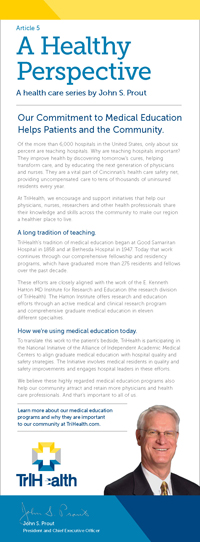Our Commitment to Medical Education Helps Patients and the Community
Of the more than 6,000 hospitals in the United States, only about six percent are teaching hospitals. Why are teaching hospitals important? They improve health by discovering tomorrow’s cures, helping transform care, and by educating the next generation of physicians and nurses. They are a vital part of Cincinnati’s health care safety net, providing uncompensated care to tens of thousands of uninsured residents every year.
At TriHealth, we encourage and support initiatives that help our physicians, nurses, researchers and other health professionals share their knowledge and skills across the community to make our region a healthier place to live.
A long tradition of teaching
TriHealth’s tradition of medical education began at Good Samaritan Hospital in 1858 and at Bethesda Hospital in 1947. Today that work continues through our comprehensive fellowship and residency programs, which have graduated more than 275 residents and fellows over the past decade.
These efforts are closely aligned with the work of the E. Kenneth Hatton MD Institute for Research and Education (the research division of TriHealth). The Hatton Institute offers research and education efforts through an active medical and clinical research program and comprehensive graduate medical education in eleven different specialties.
How we’re using medical education today
To translate this work to the patient’s bedside, TriHealth is participating in the National Initiative of the Alliance of Independent Academic Medical Centers to align graduate medical education with hospital quality and safety strategies. The Initiative involves medical residents in quality and safety improvements and engages hospital leaders in these efforts.
We believe these highly regarded medical education programs also help our community attract and retain more physicians and health care professionals. And that’s important to all of us.
